Roof Tile
Korean

Description
Subject Matter:
The lotus motif, because of its association with Buddhism, was a favorite design for the end-tiles on the roofs of Korean palaces and temples. At first the lotus medallion decorating the faces of end-tiles was single layers and consisted of six to eight petals surrounding a central ovary or seedpod. Later the lotus design grew more complex with additional decoration on each petal as well as super-imposed rows of petals. This is an example of a lotus medallion with a double layer of petal.
Physical Description:
This is an example of a lotus medallion with a double layer of petal. Two rows of eight petals each are arranged around a double-ring seedpod. The outer ring of the seedpod has no design. The inner ring of the seedpod contains a central seed surrounded by six peripheral seeds (1+6 seed pattern). The outer rim is embellished with a bead pattern.
This gray-white, high-fired earthenware concave eave-end roof tile with an eight-petal lotus design was made from fine clay mixed with a small amount of sand. The reverse side shows signs of having been joined to a flat tile, while traces of trimming and smoothing with water are also visible. The round ovary is circumscribed by double lines and contains seven seeds: one in the center surrounded by six more.
[Korean Collection, University of Michigan Museum of Art (2017) p.37]
Usage Rights:
If you are interested in using an image for a publication, please visit https://umma.umich.edu/request-image/ for more information and to fill out the online Image Rights and Reproductions Request Form.